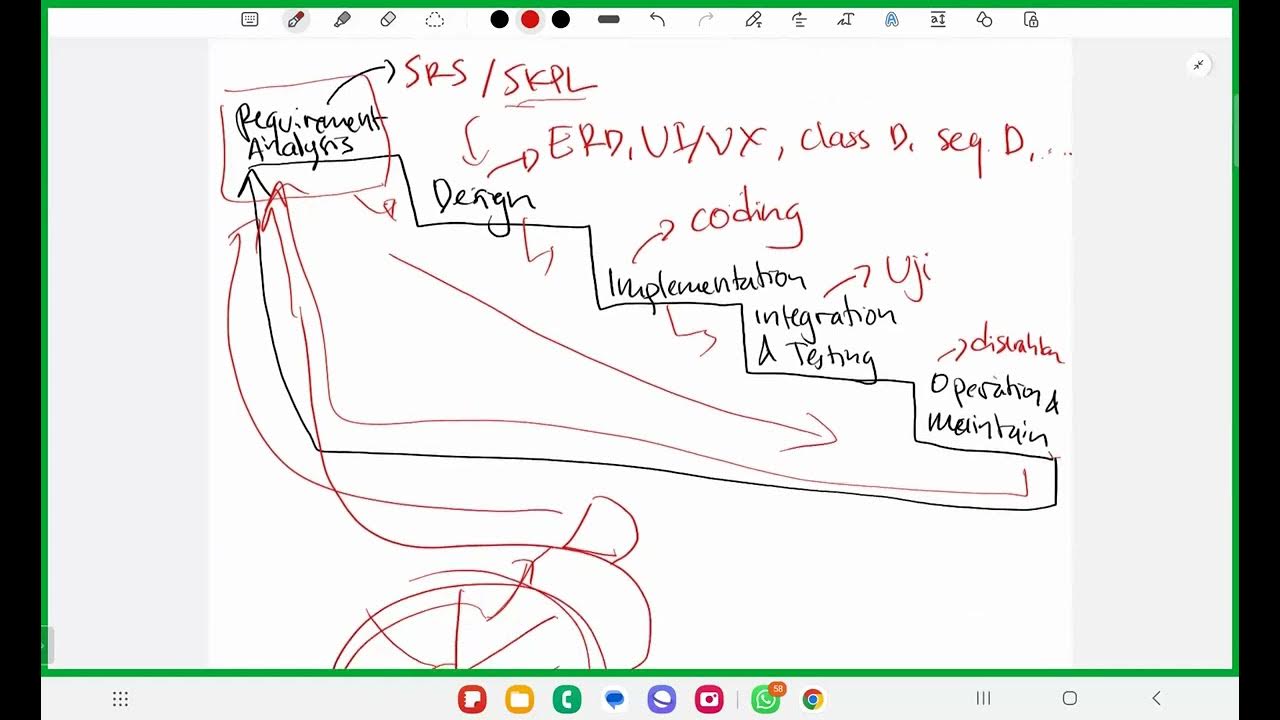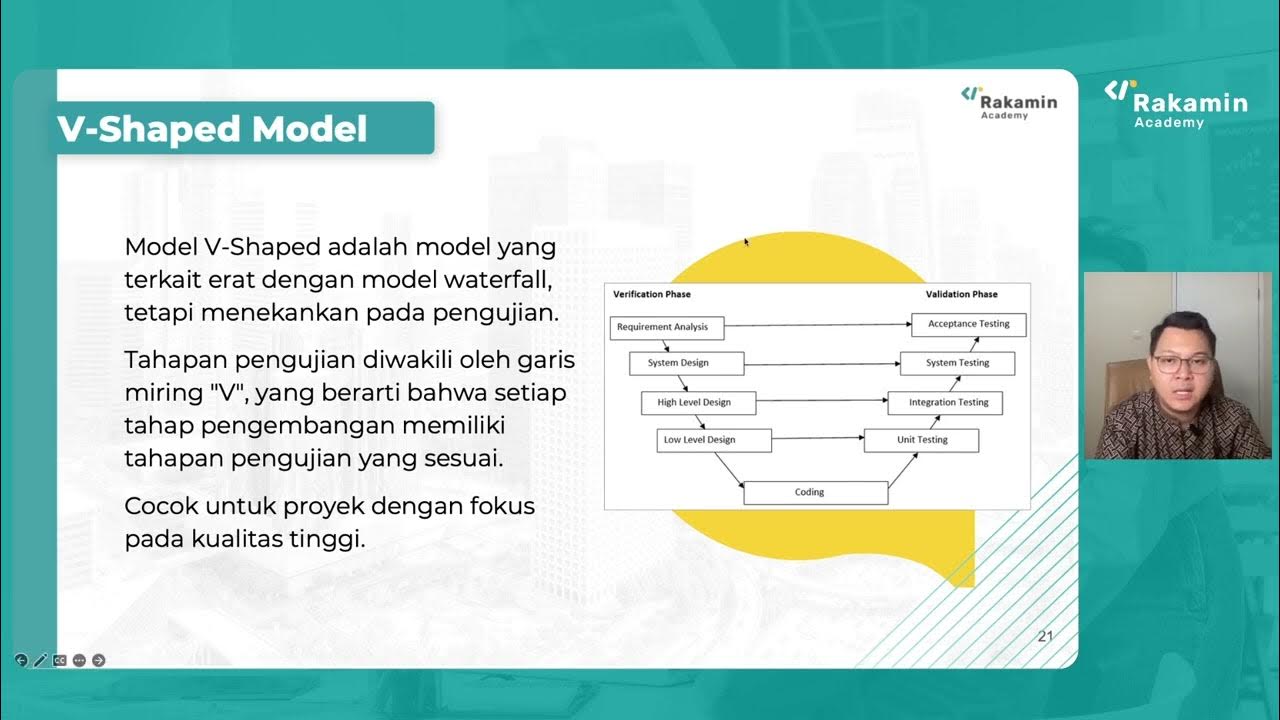Lecture 11: Evolutionary Model
Summary
TLDRThe video script delves into various software development models, highlighting the Incremental Development Model and its evolution from the Waterfall Model. It discusses the necessity for adaptability in project requirements and the shortcomings of fixed models in handling such changes. The script explores the Evolutionary Model and its iterative approach to development, emphasizing the importance of client feedback and the flexibility to incorporate changes. It also touches on the Rapid Application Development (RAD) model, emphasizing quick prototyping and customer interaction, and concludes with the Unified Process, an iterative and incremental approach to software development that involves four phases: Inception, Elaboration, Construction, and Transition.
Takeaways
- 📈 The Incremental Development Model builds upon the Waterfall Model by addressing its limitations and allowing for changes in requirements as a project progresses.
- 🔄 Requirements often change during a software project due to various reasons, including clients' inability to fully visualize the software before its creation, leading to many requirements being discarded or altered.
- 🔍 Capers Jones’s research across 8000 projects revealed that about 40% of requirements change during development, which is a significant issue not well addressed by either the Waterfall or Incremental Model.
- 🛠 The Evolutionary Model attempts to embrace all requirements and iteratively develop features based on client feedback, allowing the software to evolve and adapt to real-world usage.
- 🔑 The key difference between the Incremental Model and the full Evolutionary Model lies in the approach to requirement specification, with the latter allowing for more flexibility and less rigid planning.
- 🚀 The Evolutionary Model is sometimes referred to as 'plan a little, design a little, code a little,' emphasizing the iterative and incremental development of features based on client input.
- 🔄 The model supports changes in requirements and design throughout the development process, ensuring that the final software product is more aligned with user needs and feedback.
- 🌐 The iterative nature of the Evolutionary Model allows for the gradual integration of new features and functions, with each iteration potentially adding to the system's functionality based on client site deployment.
- 🛑 The model also acknowledges the unpredictability of software development, allowing for changes in direction and adjustments to the development process as needed.
- 🔍 The Unified Process, developed by Jacobson, Booch, and Rumbaugh, is an iterative and incremental approach widely used in object-oriented software development, emphasizing the importance of client interaction and feedback throughout the development lifecycle.
- 📊 The Unified Process is structured into four phases: Inception, Elaboration, Construction, and Transition, each with its own set of activities and iterations, culminating in the deployment of the software to the client.
Q & A
What does the Incremental Development Model address that the Waterfall Model does not?
-The Incremental Development Model addresses the limitations of the Waterfall Model by allowing for changes in requirements as the project progresses, whereas the Waterfall Model does not accommodate such changes once the development process has begun.
Why might software requirements change during the development process?
-Software requirements may change due to various factors, such as clients gaining a better understanding of what they want as the software takes shape, or because initial requirements were not fully understood or specified at the outset.
What did Capers Jones’s research on 8000 projects reveal about requirement changes?
-Capers Jones’s research found that during the development phase, about 40 percent of the requirements change. This highlights the importance of development models that can accommodate such changes, unlike the Waterfall Model.
How does the Evolutionary Model differ from the Incremental Model in terms of requirement specification?
-The Evolutionary Model, unlike the Incremental Model, does not require a complete specification of all requirements upfront. Instead, it focuses on identifying a set of features and evolving the software by adding more features based on client feedback and testing.
What is the basic principle behind the 'plan a little, design a little, code a little' approach in the Evolutionary Model?
-This approach in the Evolutionary Model emphasizes incremental development where each iteration focuses on a small set of features. It allows for continuous refinement and adaptation of the software based on user feedback and evolving requirements.
How does the client's involvement in the Evolutionary Model differ from other models?
-In the Evolutionary Model, clients are involved throughout the development process, providing feedback on each iteration, which influences the evolution of the software. This is more interactive compared to models where client involvement is limited to the initial requirements phase.
What is the significance of the iterative approach in the Evolutionary Model?
-The iterative approach in the Evolutionary Model allows for the continuous integration of new features and refinement of existing ones based on real-world usage and feedback. This leads to a more adaptive and user-focused development process.
How does the Rapid Application Development (RAD) Model differ from the Incremental and Evolutionary Models?
-The RAD Model focuses on rapid prototyping and quick development cycles, often using high-level tools and standard APIs to speed up the process. It typically involves short-term planning and customization, with an emphasis on quick feedback and iteration.
What are the potential downsides of the Evolutionary Model in terms of project management?
-The Evolutionary Model can lead to challenges in project management due to its iterative and adaptive nature, which may result in unpredictable timelines and budgets. It also requires a flexible and responsive team that can handle the uncertainty of evolving requirements.
How does the Unified Process address the iterative and incremental aspects of software development?
-The Unified Process, developed by Jacobson, Booch, and Rumbaugh, is an iterative and incremental approach that encompasses four phases: Inception, Elaboration, Construction, and Transition. It allows for continuous refinement and client involvement throughout the development lifecycle.
What is the main advantage of using a graphical representation in the Unified Process?
-A graphical representation in the Unified Process provides a visual overview of the development lifecycle, showing the phases and iterations, and highlighting the peaks and valleys of activities such as analysis, design, implementation, and testing.
Outlines

This section is available to paid users only. Please upgrade to access this part.
Upgrade NowMindmap

This section is available to paid users only. Please upgrade to access this part.
Upgrade NowKeywords

This section is available to paid users only. Please upgrade to access this part.
Upgrade NowHighlights

This section is available to paid users only. Please upgrade to access this part.
Upgrade NowTranscripts

This section is available to paid users only. Please upgrade to access this part.
Upgrade Now5.0 / 5 (0 votes)





